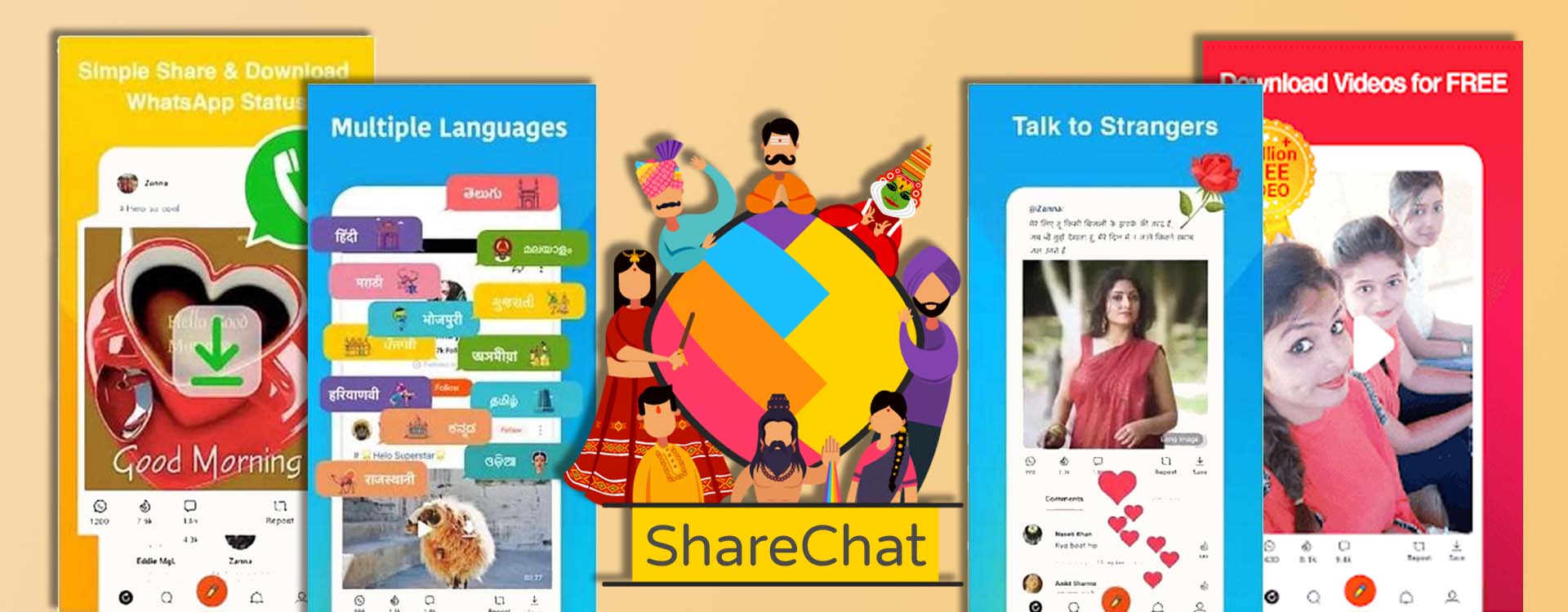Facebook and Instagram, among other social media giants, have altered the way we interact. In India, which is largely a non-English speaking country, social media platforms such as Facebook may have a high active participation rate, but they have failed to connect with the significant majority of the people who are unable to communicate in English. ShareChat, a Bengaluru-based firm that was formed in 2015 as an independent social media platform, was one of the first to notice this setback.
ShareChat: Decoding Communication for the Regional India
The three IITians, Farid Ahsan, Bhanu Singh, and Ankush Sachdeva hit the sweet spot the 15th time when Ankush stumbled upon a Facebook post inviting people to drop their phone numbers if they wish to be part of a Sachin Tendulkar fan group on WhatsApp. What intrigued him was the fact that when Facebook was witnessing questions against its privacy policy, people were not hesitant to share their phone numbers. He created 10 WhatsApp groups with 100 participants each. An hour later, the groups were filled with notifications about Sachin Tendulkar, but the content was in their regional language. They concluded that WhatsApp helped them to share regional content, but there was no exclusive platform that organically provided content in their mother-tongue.
After some research, the trio discovered that out of 350 million smartphone users in India, 100-120 millions prefer their content in English; however, the remaining users preferred content in their vernacular language. This data was expected to reach 199 million for English users and 536 million for Indian language users in 2021. This knowledge made them realise the need of creating a platform which exclusively addressed and generated content for the regional audience in India. This regional audience mostly resided in the non-metro cities and the content they preferred was very different from the metro cities residents.
In 2014, they started working on an app, gathered data and conducted a user based research for almost 11 months, and finally ShareChat was launched. Given India’s rich linguistic diversity, ShareChat was the key to fill a void left by English centric social apps, through an app designed specifically to entertain the regional audience.
“Vocal for the local”
The first version of the app was launched in December 2014 under the parent company Mohalla Technologies Pvt Ltd. They wanted to analyse how the audience would respond to the app, so that they could work on the changes further. The trio noticed an unusual activity from the users. Almost 90 per cent of the users chose to operate in English, but their engagement rate was immensely low. On the other hand, the remaining 10 per cent chose to operate in a regional language but their engagement rate was much higher. They concluded that people chose English as a language due their aspirational value and not based on their comfort and hence due to minimal knowledge of this language, the engagement rate was quite low. Therefore, they decided to scrap English as one of their choices and relaunched the app in October 2015.
The app which was built thereafter, immensely focused on just feeding its customers with content in their chosen language since the main reason why the app was introduced was to provide content only. The app was supported in four languages excluding English. The content could range from memes to GIFs to videos and the list goes on. When this content was shared on WhatsApp, it would be delivered with a watermark saying “this content is shared by ShareChat” along with a link to download ShareChat. This algorithm helped the app grow organically and initiated installs when the app was just launched.
In no time, the app had almost one lakh downloads within the next two months as the app leveraged traction through WhatsApp. The average engagement time on the app skyrocketed and the demand for new and better versions of the app were also soaring.

How ShareChat Brought about Much-Needed Customisation
ShareChat, when launched, was a chatbot based app to facilitate content as per users’ request. The app later came in many versions to personalise its content with a motive of increasing the engagement rate and moreover cater to the wider needs of its audience. The app now has 15 different languages, excluding English, and has evolved from a content sharing to a content generating app. The purpose of ShareChat was not just limited to “share and chat” but went far beyond for its users. Due to customers demand, in 2016, the app allowed customers not just to share content but to create it as well, when it launched a User Generated Content (UGC) in its system to boost its reach.
But there was a big hurdle that the company had to overcome – Internet connectivity. The target audience for this app were simply the internet consumers of tier II, III and IV cities. Back in 2015, Internet connections were not as advanced as they are now and the users lacked the range they needed to access content in no time. Therefore, the founders decided to build a similar bi-directional architecture which allowed customers to send messages and built the app in such a way that people even in the low-connectivity areas could use their app.
One of the driving points for ShareChat to become a success within the first few years of its launch, was the fact that Reliance Jio had slashed its prices and offered 4G services at dirt cheap prices as low as $3 a month for 1 GB data every day. This solved the problem of low connectivity in smaller regions in one go, paving the way for ShareChat’s success.
‘‘
ShareChat was started with a vision to make users comfortable in the digital space without worrying about English literacy.
Why Does ShareChat Stand out?
For starters, the app builds a platform to close a gap within regional communities. Regional and language diversity has been India’s one of the greatest strengths and weaknesses at the same time. It is a weakness because of a simple fact that language can prove to be a barrier in voicing out opinions. Social Media provides the greatest platforms to do so. However, the most famous social media apps are the US based tech giants who do not cater to the whole of India and neglect the regional languages. ShareChat tapped on this large market and provided a “non-English” social network platform to fill the vacuum created by the English based social networking apps.
As mentioned earlier, the app was first a content sharing and then became a content generating app. It has since evolved overtime to make it easier and user friendly for the first time social media users which reside in the tier II and III cities accounting for 80 per cent of the population of the country. The app keeps introducing new features with a motive of expanding its audience.
Let’s dive into the features which made the app user friendly for the first time users.
Shake- N- Chat
This is a very unique feature in the application which facilitates unknown users to connect on the app simply by shaking their phone. This feature will connect the user to another user who is either interested in similar content or has been creating content in a similar genre. This feature certainly strengthens the social experience of the users and can lead to fruitful conversations among the unknown users
Private Messaging
This is no different from other social media apps but this feature could help ShareChat enlarge its market. Users had to resort to other social platforms to chat with say their friends or family members. Upon conducting surveys in 6 different Indian states in 2017, 88 per cent of the users wished for a private messaging feature in the application. Against this insight, a private messaging feature was introduced in the application. This did not only help ShareChat expand its market but also the engagement time in the app increased.
Create your own stickers
Users may utilize this feature to make their own stickers by pressing the ‘stickers’ button in the top right corner of any ShareChat post. Users may also personalize the sticker by using the app’s distinctive frames. The sticker is then kept in the user’s sticker pack. And it doesn’t end here; these stickers can also be shared on Whatsapp from the ShareChat app.
Post search and Repost
Post search feature intends to make searching for postings on a user’s account easier and faster. Users may do this by typing a term into the ‘search’ icon at the bottom of the home screen, and the postings that match that phrase will follow. As the name implies, the functionality will assist the user in filtering the postings in their account, limiting the search criteria.
The repost feature allows the user to re-share a post on their ShareChat account by pressing the ‘repost’ icon at the bottom of any post. Re-shared posts will appear in the feed alongside other posts, but with the original user’s username and profile photo.
Tech Giants’ Obsession with This Home-Grown Rival to WhatsApp
India Quotient was one of the first companies to invest in ShareChat in 2014 with an amount of 50 lakh rupees ($67000) for a 10 per cent stake in the company. This decision was laughed off by many, questioning if just an idea on a paper could get thousands of dollars. However, India Quotient was confident enough to invest in the company based on its idea. Madhukar Sinha, the Co-founder of India quotient had worked closely with the three founders of ShareChat and knew the potential of the brand. Hence, this decision was a no-brainer and the company kicked off with its first investment funding round.
Till date ShareChat has raised an amount of $824.8 million across 10 funding rounds. Their last Series E funding round alone raised $502 million taking the valuation to $2.1 billion.
What doesn’t come as a surprise is the enthusiasm of tech giants for the Indian market. India has become the second fastest internet growing economy hosting 650 million users online which is predicted to cross 900 million by the year 2023. Hence, they do not leave any opportunity to invest in this growing market.
Twitter has been one of the leading investors in ShareChat. Other investors include Xiaomi, Lightspeed Venture partners, Tiger Global management, SAIF partners, Shunwei Capital and many more.
Since ShareChat helps newcomers to the internet, who have no knowledge of how discovery works, by bringing the content to them, Twitter tapped into this opportunity and utilised this approach to grow its reach in regions that would otherwise be inaccessible to them and monetise new users through advertising. ShareChat is the only Indian start-up which has been invested in by Twitter, that too twice. Infact, Twitter invested more than it planned to after TikTok was banned after a standoff between India and China. Soon after that, ShareChat launched ‘Moj’, another video sharing app which reached 10 million downloads just six days after its launch. Twitter plans to make Moj international and a global rival for TikTok and hence, invested a huge sum in ShareChat to deepen its technology.
What does the future hold for ShareChat?
Google and Snap (parent company of Snapchat) are in talks to invest in ShareChat. Twitter is offering to acquire ShareChat with an aim to build a global rival to TikTok. The results of these talks are yet to be seen.
Given the fact that 9 out of 10 people in India prefer to communicate in their native dialect, the future shines bright for ShareChat. But the challenge remains; there are 22 official languages, 122 major languages and more than 1600 dialects and currently, ShareChat has a long way to go to reach this ever-growing population and widen its accessibility for its vernacular-based users.
For more inspiring stories check out our Inspire section!





Wow, this is incredibly interesting!
And overall, so well written!